Who doesn’t love a good prodigy story? Our wine world abounds with hyperbole about the genius and extraordinary talent of the very young. This makes it a bit of a conundrum when deciding to include wine professionals in this category of inspired people (at least when compared to musicians and artists) because viticulture and winemaking aren’t taught in kindergarten or elementary school—though in Europe they are taught in high school.
Rarely do we taste wine on-site with a new potential partner before first doing ample research and purchasing a few bottles to try. However, context does come into play, especially when a reputable connector is involved. On a three-day November trip with wine industry friends, our Nizza Monferrato revolutionaries at Sette mentioned that if we had time to meet Daniele Marengo, we absolutely should.
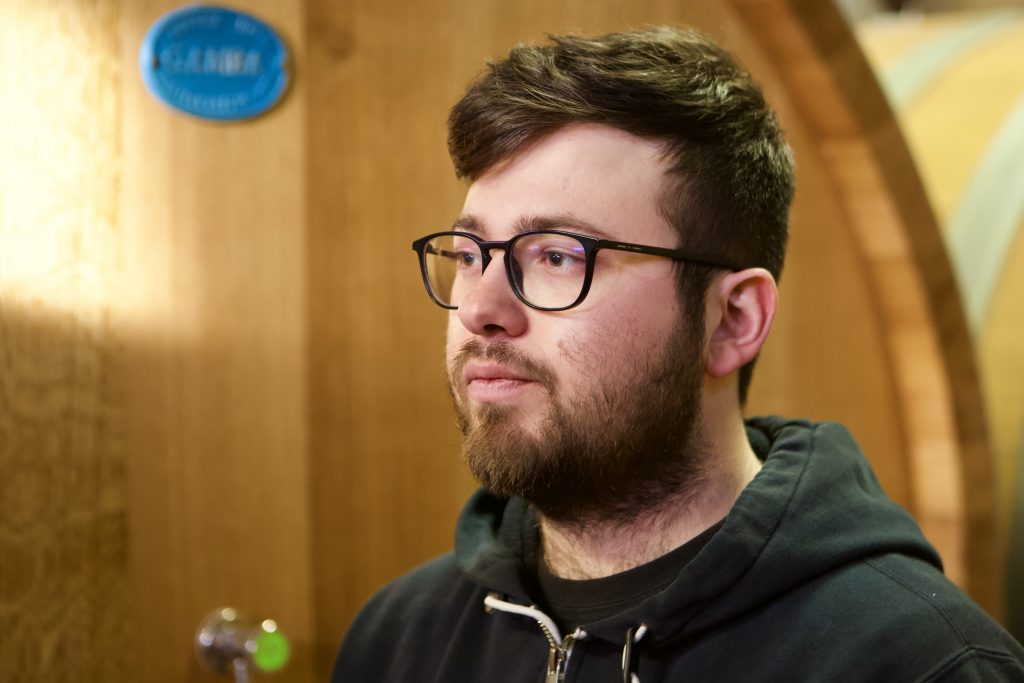
The 2021 Nas-Cëtta was a great start, and the 2021 Dolcetto that followed was mind-blowing. (Yes, Dolcetto can be exactly that.) It was a maturely crafted complex wine with a suave texture from a young vignaiolo who already seemed to have had a full lifetime of contemplating and finding Dolcetto’s truest form. The Barbera was a fabulous follow-up, but when we arrived at the Langhe Nebbiolo, we all said little and sat in front of the quiet Daniele sharing glances of disbelief at the strength and maturity of these four starting-block wines. The mark of the greatest producers is often found in their entry-level wines as well as those in their top billing. If they’re not solid and consistent, their top wines won’t be either. However, a strong starting range is no guarantee of quality for what comes after.
Though it’s not fair to speculate on Daniele’s potential while he’s only nearing the quarter mark of his life, we do see the genius early on. It’s even rarer in a region as important as Barolo for someone so young to be given full control and to generate such high-level results so quickly. In our portfolio of growers, there are few so impressive in their early twenties from one of a country’s most celebrated regions. (Our Chablis grower, Romain Collet, comes to mind with his first vintage in 2008, at age 20.) Is Daniele a prodigy? Not sure, but it will be a privilege to watch his progression from the front row.
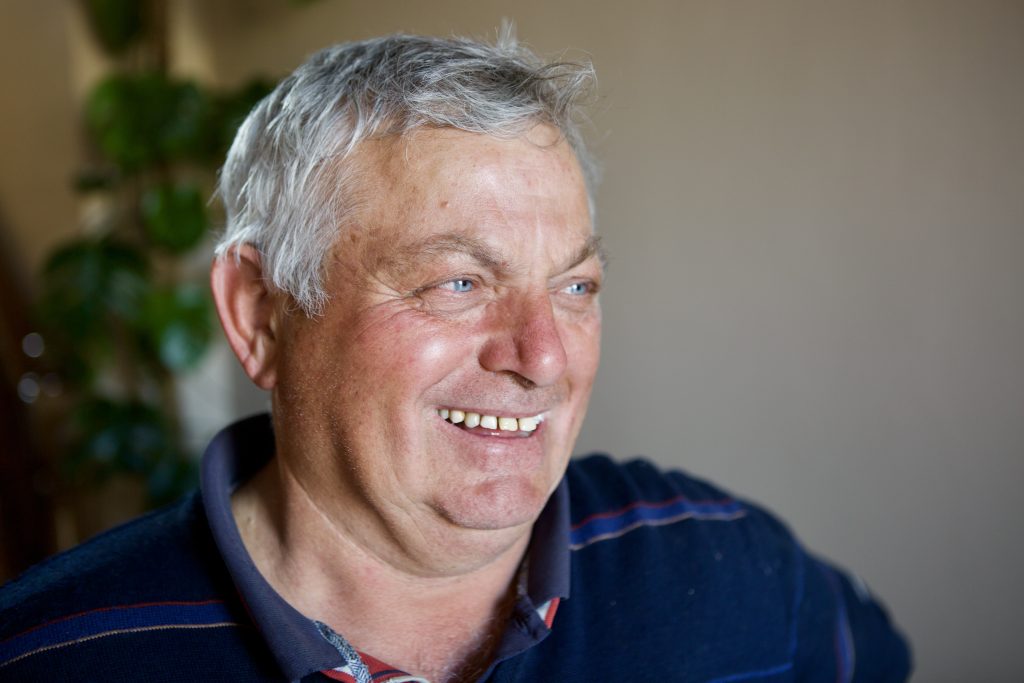

Born in Alba in 1961, Mauro Marengo left middle school to help his father Francesco take care of their many different crops and livestock up until the 1980s. Incentivized by the increasing global success of their wine region, they slowly moved more of their effort to viticulture, and in 2015 they made their first commercial wines. Daniele describes his father as having the peasant pragmatism of the Langa and a strong attachment to the land.
What is most unique about the Marengos and the typical Piemontese familial agricultural system is how early they began to pass the torch on to their children. They started to first give control over the business to their daughters and convinced by Daniele’s obvious talent and passion for the vineyard and cellar work, some years later they gave him, at twenty-two-years-old, their full support of his ideas and the directional control in the vineyards and cellar. However, Daniele was involved from the start with the microquantity of wines bottled under the family label in 2015 when he had just entered his teenage years.
“My father was very forward-thinking and created a true generational transition, leaving my sisters and me the possibility of embarking on a new path, while always remaining by our side, listening to our ideas and trying to understand them without putting ‘spokes’ in them.” -Daniele Marengo
Today, in 2023, with their twenty-eight hectares of land (four for hazelnuts, nine for wheat, and fifteen to vines), they still sell more than 70% of their grape production with the goal of eventually bottling two-thirds of the best parcels each year for their family label, while continuing to sell the remaining grapes and wines that don’t make their quality standards to negociants.
While waiters and restaurant managers prioritize hot food above all else, the entire Marengo family, like most agricultural families, is all hands on deck for harvest. The cast of characters begins with Daniele’s grandmother, Angela, who, despite being born back at the start of WWII, still spends her days in the cellar and vineyard. She and her late husband, Francesco (1933-2021), brought Mauro and Annamaria into the world. Annamaria works in a bank and helps during harvest. Mauro continues to take care of the overall family business and remains the family’s main tractor driver and is now a sort of “cellar assistant” to Daniele while working in the vineyards and other fields. Lucia, Mauro’s wife, works in the vineyards and manages the money. Mauro and Lucia’s firstborn, Gabriella, who earned a degree in Management, began to work for the family in 2014 in administration (a full-time job for every business in Italy); her husband, Cristian, helps with vineyard work and other tasks. Their second daughter, Elisa, is the family Graphic Arts major who studied in Genoa and Paris. She creates their attractive, stylistic labels and does business marketing and communication, and, of course, she also works in the vineyards. Elisa’s husband, the artist Pierpaolo, helps where he’s needed, but mostly with public relations. And then there’s Daniele.

A pleasure to visit with not only because the wines are invigorating and exciting, Daniele is also humble and generously hospitable. In response to questions, he emanates a sort of eccentric, genius-like aloofness, with lengthy pauses to reflect before answering in his naturally soft manner; then the meditative tranquility is often jolted by his thunderous laughter.
Daniele graduated in 2020 from the University of Turin’s Alba branch with a degree in Viticulture and Oenology. He began his master’s too but abandoned it to focus on the family business. The third and last in line, he slowly found comfort and resolve to follow the inevitable road toward becoming a vignaiolo. “I think it was a slow realization during adolescence that this path was too tempting to not be taken. Over time I realized that it was what I needed, and it is something that gratifies me.”
Acknowledging his young age, Daniele hesitates to be firm in his ideas. Even if his thoughts are that of a revolutionary, his newly incorporated practices aren’t, in principle, they’re just simple and smart, the way a sushi chef does little with a perfect piece of fish with naturally pure flavor, nothing but cut precisely and plate with care and intention. As with wood-grilled, fatty bellota-hogging Ibérico fresh cuts like pluma, presa, and secreto, there is little to incorporate except the right cooking temperature, quality of the wood and the right moment of its embers, and good finishing salt to further animate the naturally decadent flavors from this extraordinary race of pigs of terroir. When one has beautifully farmed grapes, the most clever makers also do as little as possible and rely on basic techniques and, most of all, their intuition.
Daniele explains that with his opportunity to direct the wines, they began with the most important part: to give greater attention to soil health, incorporating organic farming and seeding cover crops that help with erosion, especially on the steepest hillsides, and to replenish micronutrients that the vines exhaust. In the cellar, his personal taste and style of wines pushed him to pursue freshness over power and ripeness to highlight their Novello-based high altitude assets; this includes earlier picking, considerations for whole-cluster fermentation, more delicate maceration practices, gentler pressing and slower, less vigorous racking, along with earlier bottling to preserve even greater vitality. In short, to keep the wines fresh, clean, and not overworked.
The secret to great winemaking is no secret at all. Every touch in the cellar can increase components or diminish them, and utilizing perfect grapes that are processed with the intention of highlighting the vineyard handling, the intricacy of the terroir and seasonal nuances requires not only doing as little as possible but also knowing exactly when to do what to achieve the desired result. Every compelling wine is designed by intuition, connection, talent, and the skill of its maker. Daniele Marengo’s ability to realize his objectives to these ends is extraordinary.
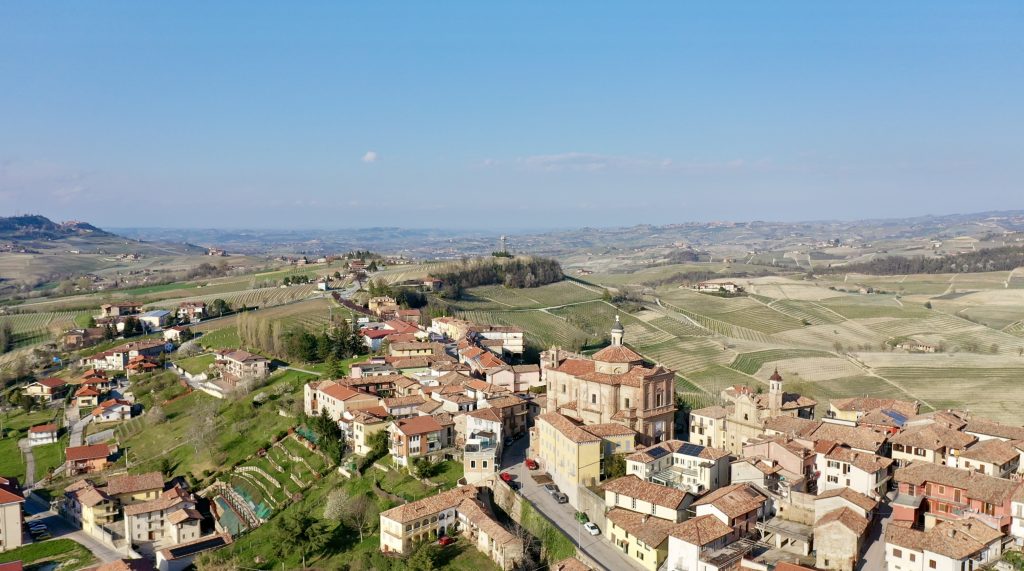

Marengo’s fifteen hectares of vineyards are in Novello with some crossover into the Barolo commune with their Terlo cru. Their collection straddles the southwest ridge above the town of Barolo, with their Barolo crus, Ravera and Terlo, on the eastern side, facing east and contiguous from one cru border to the next with altitudes ranging between 350-410m. A series of Nebbiolo parcels and Barbera sit on the top of the ridge plateau around 400-420m. On the western side are more Nebbiolo and Barbera on the highest parts and Nas-Cëtta and Dolcetto just below but still a little over 400m. Everything is on the typical Barolo calcareous sands and here the grayish blue calcareous marls.
Everything is moving toward organic farming, which is clear as one walks the vines, the greenest rows in the area. While new generations continue to push for more natural ways of farming, there is still solid incentive remaining in Barolo and Barbaresco for growers to sell bulk fruit or wines to negociants, therefore there are far more non-organic sites than organic ones. In Novello, Marengo’s vineyards stand out because they are healthy, green patches often surrounded by desert-like plots packed with vines.
Novello has an advantage in the medium to long-term outlook with regard to climate change compared to a lot of other areas of high-quality Nebbiolo production; Daniele’s land is more stable, perhaps not for a hundred years, but certainly for this generation. What in the past were advantages and disadvantages regarding altitude, exposure and wind protection have begun to flip over recent decades, and the hierarchy is changing. The higher altitude of Novello and exposure to strong winds help to “clean” vineyards, i.e. keep mildew pressure lower than other more sheltered areas. Marengo’s two Barolo crus are both exposed due east and lose hours of the scorching evening sun in the peak of summer and fall because of their steep exposure at the crest of the hill, with its gorgeous view of the Barolo village below and vast expanse of the cradle of the Barolo appellation.

More widely known as Nascetta but spelled Nas-Cëtta in Novello, Daniele’s first cracks at this grape are beyond expectations from a new winegrower and perhaps even from the variety itself. The vines are young and the wines are vigorous and fully expressive with a lead interplay of reductive elements, mineral impressions and soft, savory grasses, honey, and white fruits. The style is hard to capture at this moment because he’s evolving quickly from one vintage to the next, but sensations like salty, high-toned, and energizing have been captured thus far—imagine the result if Arnaud Lambert and Olivier Lamy teamed up for a Nas-Cëtta project.
“What I like about this wine is that it never bores you. In its youth it is not too fruity, therefore it’s not cloying. It’s well balanced between the floral and fruit aromas and over time it acquires complexity and volume in the mouth, without ever being static and repetitive.”-Daniele Marengo
The vineyards are in the località Tarditi on the west side of Novello and are exposed directly west toward the Tanaro Valley with a glorious view of the snow-capped Alps that tower over this gentle slope at 390-405m on bluish-gray marl, clay and silt topsoil. More Nas-Cëtta will come from a new plantation in Zora, which is on blue marl with pale calcareous sand topsoil located west of the località Serra, north of Novello’s center and close to the family winery and home.
Daniele wants to craft a vertically shaped Nas-Cëtta while integrating the variety’s aromatics and mineral components that over time become more expressive in the back palate. He says that the marls of Sant’Agata make whites with great structure, but because they are at a high altitude with full exposure the plots experience large temperature shifts which helps maintain freshness. He also points out that a strength of Nas-Cëtta is that it’s good right away but even better four years or so after bottling.
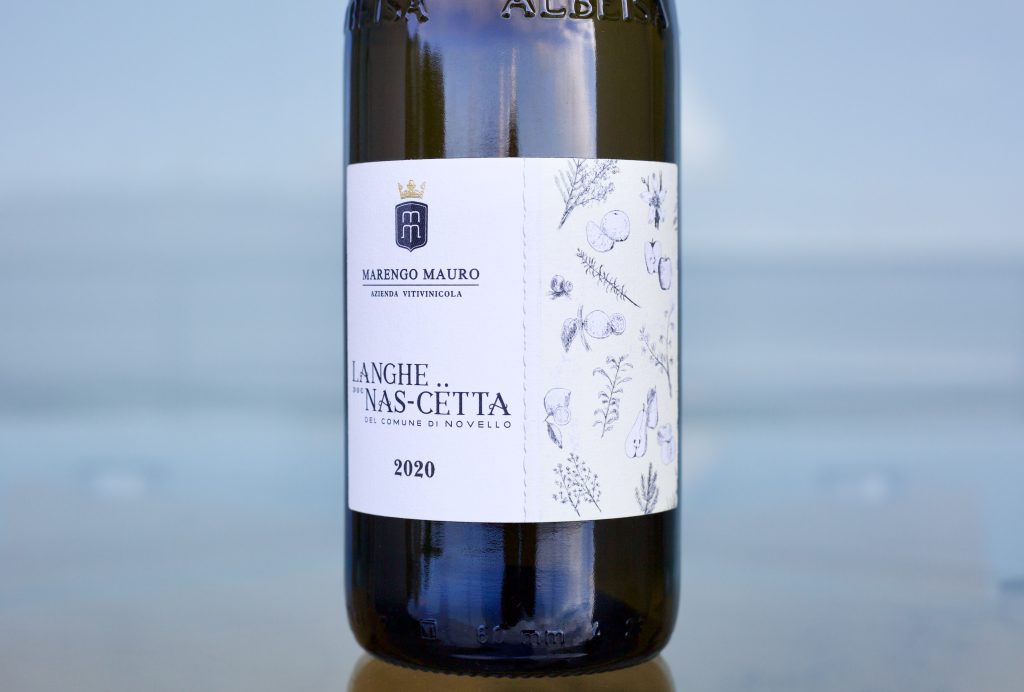
In the cellar, a natural fermentation takes place with controlled temperatures for about 20-25 days in steel. During cellar aging, it’s racked a few times prior to bottling and only filtered if turbid. Sulfites are first added after primary fermentation. It doesn’t pass through malolactic fermentation and is not fined nor filtered.

The overall red wine profile with young wines at Marengo is led with a tinge more purple than red fruit. Most likely a result of picking decisions and the cellar approach, the darker fruits may also be partially attributed to the higher altitude and a longer ripening period on parcels that face more toward the east, like Ravera and Terlo.

Smitten by Marengo’s 2021 Dolcetto, we were temporarily heartbroken during our second visit to the cantina in April 2023 when, after extolling the virtues of his 2021 and claiming we’ve not had better young Dolcetto, he softly broke the news that he had changed the style for the 2022.
“What fascinates me about Dolcetto from Zora is its wealth of nuances from florals to fruits rarely found in other Dolcettos, and it gives me emotion as it’s poised between fragility and at the risk of being off balance.” -Daniele Marengo
Despite the profundity of the 2021, Daniele was right to change. He felt the 2021 fruit was slightly too mature (though only just barely), and that behind all the glory of the 2021 lurked minuscule evidence of grapes leaning toward the other side of perfect ripeness for those in pursuit of a shimmering Dolcetto. Fruitiness in Dolcetto is especially easy, but Marengo’s are now even more vigorous and taut. Starting with 2022 there’s much more red fruit than dark. It’s so finely tuned and delicious that it feels like he’s based his reputation on it, like the Dogliani growers who lead with Dolcetto. The 2022 has a similar feel to those in Dogliani and shares similarly high altitudes as in Novello. Here, they’re fresher and brighter by nature than many areas of the Langhe.
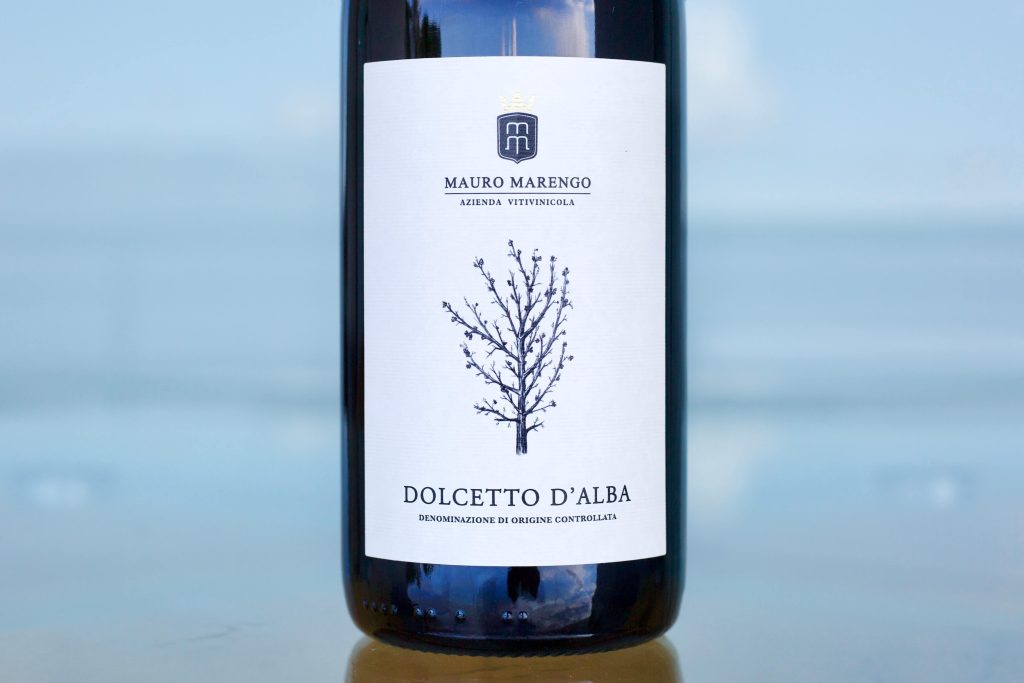
I was once told that using “floral” in a description would kill a wine sale. I, for one, have faith that many tasters aren’t put off by and even adore these elements. Sure, nonna’s excessively floral perfume isn’t appealing, but some consider the scent of real flowers to be aromatic vinous equilibrium. Wines with white, pink, orange, red and violet scents, and the finely tuned to voluptuous sweet versions of rose, can be the mark of well-timed picking decisions, good winegrowing, gentle cellar work, and varietal distinction. Once a wine loses all its floral aromas, there will be less to appreciate.
Red wines from the world’s greatest terroirs often have floral elements not only present but often in the forefront when they’re young and continue to pleasantly haunt decades after their birth. Rusticity, earth and balanced ripeness are essential to complete a vin de garde wine’s depth, but the best don’t burn the floral elements out of the mix in the vineyard before picking the fruit. Grapes picked with a snappy-to-the-tooth texture and freshness often immortalize the floral elements.
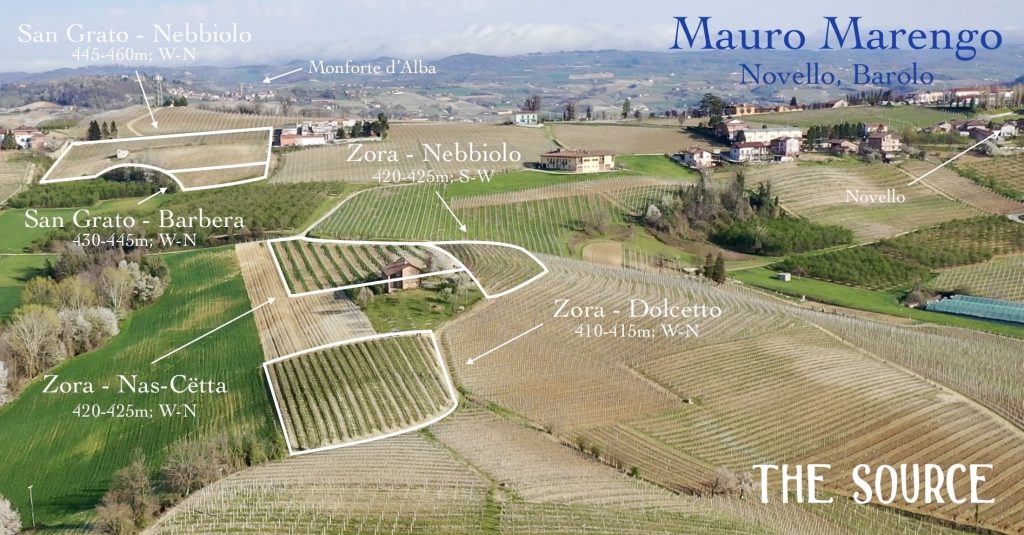
Daniele’s new Dolcetto style is led by sweet, bright, and rich floral aromas of an expansive and sunny field of flowers in bloom after a spring rain. Red fruit charges second, though not blaring fruit like a lower-altitude sandy soil Fleurie or Morgon. Spice is third: think Brouilly/Côte de Brouilly/Marsannay. The fourth, which seems an inevitable part of every Dolcetto, is its earthy, savory components that begin their journey in the caboose but saunter their way to first-class. Their west-facing, eye-watering, hazy Piemontese sunset, high-altitude Dolcetto vineyard buffers the cool Alpine gusts before they charge over Novello and down into the belly of Barolo. We often speak of the predominance of soil elements in the terroir, but this mountain-fresh Zephyrian wind imparts the tension Daniele captures in the latest version of Dolcetto. On day two, it loses nothing. Rather it gains in suppleness and filigree texture, remaining as good, if not better, than its stunning first hours open.
In the cellar, its fermentation lasts between 8-10 days with a couple of daily pump-overs depending on the vintage. After pressing, it checks into 25hl steel tanks for hibernation until the following spring. Depending on each vat’s level of reductive elements, they may be racked three to four times during élevage and then again once or twice prior to bottling. (It’s incredible that they remain so fresh after so many movements.) Sulfites are first added after malolactic and it’s neither fined nor filtered.

Marengo’s Barbera d’Alba Superiore follows suit with the overall bright-and-lifted style of their range. Daniele’s interpretation draws attention to the variety’s high natural acidity and impact while highlighting the beauty of their high-altitude and wind-exposed terroir’s naturally fresher and brighter fruit. Aromatically spicy and exotic with light purple fruits and flowers, the palate is tight with rousing acidity and only a slight, sappy glycerol quality.
The Barbera vines are eight years old (as of 2023) and are on the western side of the highest part of Novello in the località, Serra. Close to the ridge that separates the east and west exposures of the municipality, they face west with a faint tilt toward the north. Fully exposed to competing cool Alpine and salty, humid Mediterranean winds, the vines sit at 430-445 meters on the soft blue-gray marl bedrock (perhaps it’s better to call it a subsoil because it’s not hard rock, per se) with reddish-gray clay topsoil—a unique terroir with wines strong in core concentration, exotic perfumes, and exhilarating freshness.
During its 13-16-day natural fermentation and maceration it’s pumped over two or three times per day, settled in tank after pressing for a short period and then housed in 10hl botte for 9-11 months followed by another three to four months in steel prior to bottling. It is neither fined nor filtered.

Barolo will be the world’s measure of Marengo’s success, but their Langhe Nebbiolo is the foreshadowing. Released at least two years before the two Barolos, Daniele’s Langhe Nebbiolos made when he first started gave a preview of what will undoubtedly be a storied career. The 2019, the predecessor to his first solo vintage at the helm, is superb and was put to bottle before his twenty-second year; a great vintage indeed, and easier to hit the mark by any less-experienced winegrower. Marengo’s 2020 is more impressive and competes with many thoughtfully made Barolos in fluidity of craft and style, lending credence to the idea that for many cantinas it will be another dark-horse season between two more celebrated vintages. But Daniele’s is the perfumed and brilliant 2021, a finely etched garnet gemstone of seductive red fruit with operatic red rose and lightly minted confiture notes that burst from the glass (between the six bottles taken in the spring and summer of 2023) is surely his finest Nebbiolo to date.
“I want a Nebbiolo that leads with freshness and fruit, a wine that seduces at first glance, radiating vitality while maintaining balance.” -Daniele Marengo
Taken from various plots high on the plateau inside the località of San Grato and Zora, and at the top of Ravera and Terlo, tension is the backbone of this fresh-fruited Nebbiolo. With altitudes that range between 380-460 meters, the parcels, La Volta (410m), Zora (420-425m), and by the cantina in San Grato (445-460m) are on the gentler slopes and tilt toward the south and west and are fully exposed to sun all day. They share the blueish Sant’Agata Fossili marls, but La Volta has slightly reddish clay topsoil (perhaps due to the presence of more iron) while Zora has a topsoil of pale calcareous sand. By contrast, Ravera and Terlo sit between 380-430m and take a focused hit of the morning sun and miss the last hours of the sun’s intense heat, preserving even more tension and fresh minerally textures.
Daniele explains that the MGA La Volta’s clay gives a stronger tannic base and structure, Zora and San Grato more elegance, finesse and higher aromatic notes, and Ravera more softness and depth. The mix of these higher altitude sites, their varying degrees of phenolic ripeness and individual terroir complexities make for a diverse and impressively nuanced starting Nebbiolo.
During the vinification there is some inclusion of whole bunches but it’s typically less than 10%. The parcel selection changes from year to year based on the quality of their main Nebbiolo parcels, though Terlo is usually the smallest proportion. For example, in 2020 it was almost entirely La Volta, while the 2021 is mostly from Ravera’s upper section—the answer to why the 2021 plays at a different amplitude than many a Langhe Nebbiolo from celebrated growers and the 2020 is more power than finesse. The 2020 was aged in new 30hl botte, while the 2021 was aged in many different barrel sizes of varying ages. It’s fermented naturally in steel and concrete, and the macerations last about 25-27 days with daily pump-overs: three in the first days and one further into the maceration. Temperatures in steel are controlled while those in concrete are not.
After pressing, the wines are racked once or twice before going into 10-30hl concrete and wood vats for four to five months, selected for quality, then racked into steel for another two months before bottling. Sulfites are first added after malolactic, and it’s not fined nor filtered.
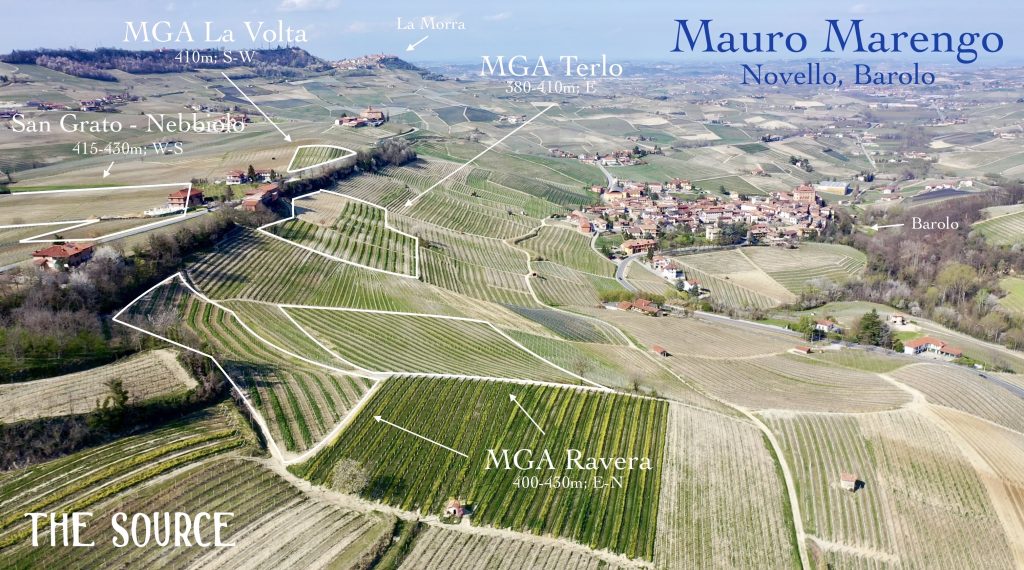

Marengo’s Terlo vines are in the upper section of this very steep MGA (Menzione Geografica Aggiuntiva—which encapsulates terroir/cru/climat/etc.) of the Barolo commune. Planted in 2018, the vines sit at 380-410m and are completely exposed to the east overlooking the town of Barolo. It’s also adjacent to Ravera, an MGA mostly located in the commune of Novello with a small patch inside of the Barolo commune.
Ravera has great diversity due to its 130 hectares of vines and its many exposures between 300-480m. While it’s a very large cru with many expositions and a massive altitude range, Marengo’s Ravera is on the far north end and is adjacent to Terlo. It also faces east with only a slight uptick from Terlo in altitude to 430m. Planted between 1997 (the year Daniele was born) and 2003, the upper section of Ravera is selected for the Langhe Nebbiolo, while the lower section is the Ravera Barolo. The reason for this distinction between the parcels used for the Langhe Nebbiolo and the Barolo isn’t specifically the altitude, it’s likely the slight geological shift between the upper and lower portions of their Ravera plots. This is best explained by Alessandro Masnaghetti, the Langhe’s terroir revolutionary. On his website, www.barolomga360.it, he states that Terlo and Ravera share the same basic geological formation of “laminated Sant’Agata Fossili marls, except in the higher areas where there are also sandy Sant’Agata Fossili Marls and Diano Sandstones.”
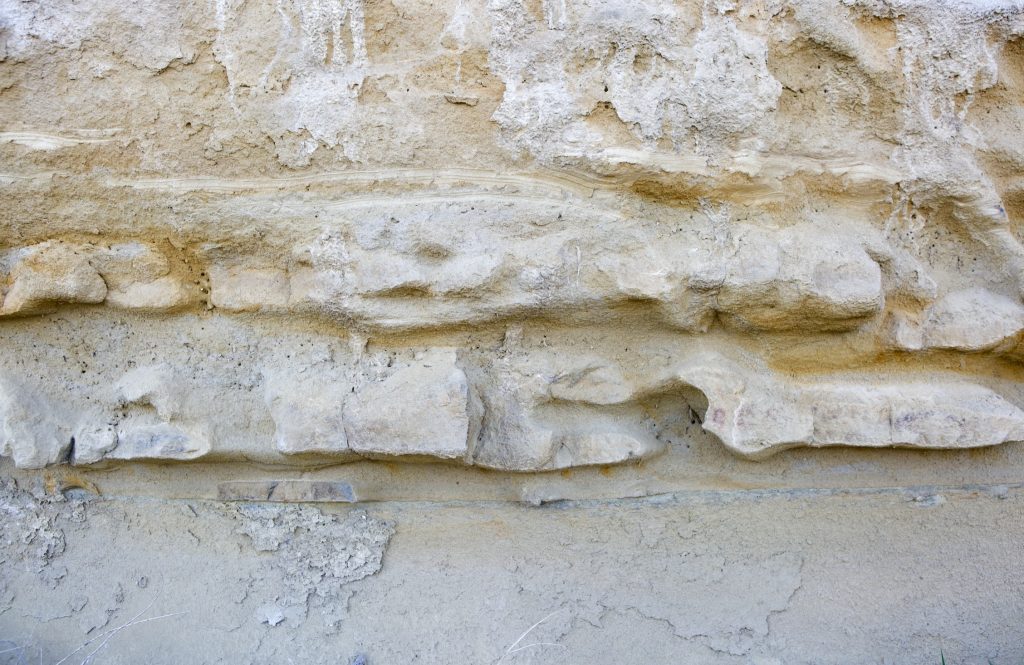
The most important takeaway from Masnaghetti is that the sandier zones are higher while the greater density of marls are a little lower on the slope. The vines on the more marly soils make more formidable wines than those on sand, though those sandier sites bring so much beautiful aroma! Other digestible terms in that sentence: laminated, marls, and sandstone. (Sant’Agata Fossili and Diano are simply the names of the formations taken from areas/villages in which these formations were likely first studied.) “Laminated” implies a sequence of sedimentary rock layers, and in this case they are small-scale sequences that Masnaghetti describes in his “Barolo MGA Vol. I, Second Edition,” which “consist of strata of variable thickness which range from a few fractions of an inch (millimeters) to something less than a foot.” Marls are a soft rock formation and are classified as such if they contain 35-65% (calcium and/or magnesium) carbonate and 35-65% clay. Sandstones seem self-explanatory, but what holds the sand grains together (which are almost always siliceous sand grains) may play a role in a wine’s expression. For example, some of the binding/cementing material between grains could be of siliceous or calcium carbonate origin.
In many global wine regions, bedrock and topsoil are either totally different, have slight variations, or consist of the same material. In Barolo’s hillside vineyards, because of their youth and how long and easily they have eroded, most of the hillside vineyards (though those on or close to valley floors may be different) have topsoil derived almost exclusively from their underlying bedrock. In the case of Marengo’s vineyards, we can assume that, excluding the organic material, the topsoil is bedrock derived.
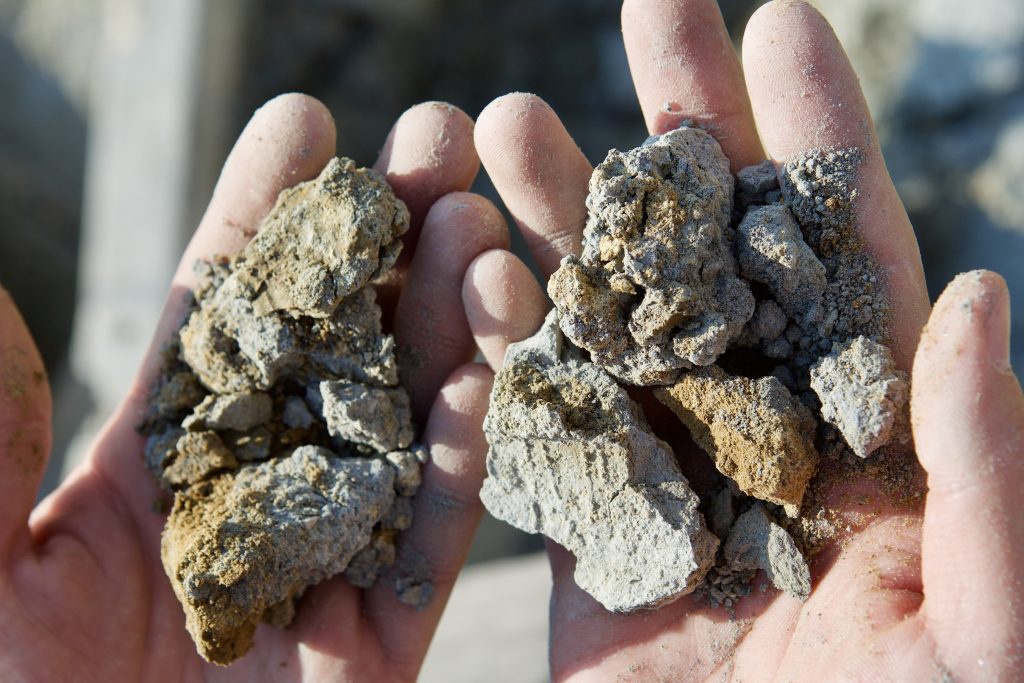

Like the other wines in Marengo’s range, the Barolos could be described as aromatic, elegant, and understated. They are also dominated in their youth by more purple notes than red, and both bottlings benefit greatly from more aeration after opening (though not specifically decanting, just time in the glass and a slow evolution of the open bottle), especially the aromatic fluidity. Not surprisingly, there is a significant relation in overall structural style to the elegant high-altitude wines of the La Morra and Barolo communes more so than Castiglione, Serralunga and Monforte, likely due to their slight geological differences.
In the cellar, both Barolos undergo natural fermentations with maceration times for Angela between 32-35 days and 35-38 days for Ravera. They both undergo three daily pump-overs at the beginning of fermentation and one or none in the later maceration period. Ravera may undergo a submerged cap fermentation, but this depends on the year. Both wines are racked once or twice prior to going into 25hl botte for 20-22 months and an additional two in steel. The wines are neither fined nor filtered.

Daniele and his family did well in 2018 with what some critics consider an enigmatic vintage. This is understandable within the context of the classic big hitters of Langhe and the style developed over recent decades. However, it’s not difficult to experience them as delicious wines with different personalities from other special terroirs. They’re not more or less special than others, just different and better utilized in specific occasions where more robust and tannic Barolos might be a little much. One only needs to appreciate wine for the sake of its intention to deliver both pleasure and intrigue to see the light inside many 2018s. Our experience drinking 2018 Barolo and Barbaresco wines from high-quality growers is that they are wonderful and in many cases an exciting departure from the typical seriousness of wines labeled as these DOCGs. The 2018s are also on par with today’s desire for higher tones and easier drinking. Nebbiolo has guts but it also maintains its composure in different, non-classical vintages. 2018 wasn’t easy to navigate, but those who work hard every year produced compelling results anyway.
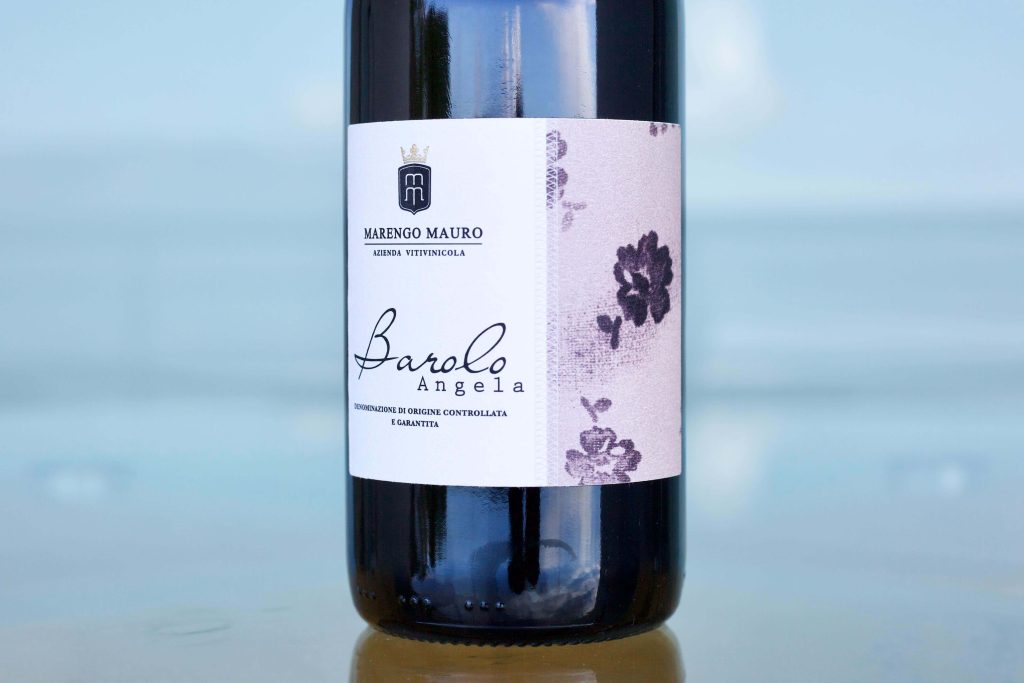
The Marengos also crafted a fine 2018 Barolo but with an expectedly more subdued structural quality. In its youth, its more notable qualities are found in its bright yet gently delivered perfume. Due to the season’s challenges and the expectations attached to the historic Ravera cru, they opted to only bottle their Angela cuvée, named after Mauro’s mother. Because the 2018 Ravera wasn’t bottled on its own, the 2018 Angela has more Ravera in it than normal years; it typically has about 80% Terlo, 20% Ravera, and in some years up to 5% from their other MGA in the commune of Barolo, La Volta. 2018 is pretty but it needs time open (though not long) to work out of its linear and slightly coarse start to begin filling in and building up to its DOCG’s stature.
The 2019s are a shoo-in for most growers and Marengo’s Angela and Ravera will not disappoint. A big uptick from the charming 2018, the 2019 Angela is fuller, rounder and more fleshed out.
The 2019 Ravera tasted in the fall of 2023 was aromatically tight at first, which is often a good indicator of stability for cellar aging and provides the right lengthy pacing for a nice long conversation over dinner. However, it loosens quickly to reveal its kaleidoscopic aromas of violets, lavender, orange peel, Persian mulberry, purple plum, and purple wine grapes, with spice, tar, leather, porcini, and wet forest. The tannins build as it opens and works into beautiful harmony and fluidity.
Both Angela and Ravera live up to the expectation of this highly revered vintage and are a telling preview of what is to come from Daniele, especially considering that 2020 was his first year of full stylistic control. I admit that I’m excited about 2020 Nebbiolo-based Langhe wines in general because what I’ve had so far is compelling and a vintage with deeply joy-filled wines with seriousness tucked into the background.
Looking toward the future, Daniele is on the move and headed in only one direction: up. During our second visit in April 2023, Marengo’s 2020-2022 wines out of vat were the hair-raising level one expects from only the top growers. They were exhilarating and vibrated with electricity. Indeed, we must remain cautious with unfinished wines that taste extraordinary before bottling because they change. However, with the passing of the proper time after bottling, we expect them to be even better.


